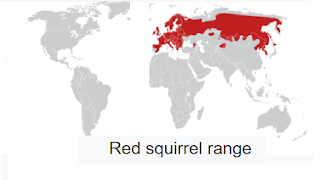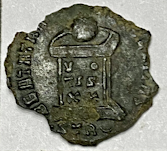I thought that instead of hiding this away in the comments to a post from April 2019 ('
Collectors' Corner: Clacton's Bazaar (Bizarre) Modern EBayPalaeolithic', PACHI Saturday, 13 April 2019), I'd make a post on it. The topic seems to have important implications. For some time now I've been interesting in the word of stone tool collectors as another side to collection-driven exploitation of the archaeological record - it's not just "metal detecting". In the course of this, one finds that a considerable quantity of items are being offered online by sellers as lithic tools and artefacts that are clearly nothing of the kind. Surprisingly, this includes at least one of the major auction houses selling such things in the UK. But it is most prevalent in peer-to-peer sales among collectors. In the post mentioned above, I look at the sales offers of two individuals who've been picking stuff up from a beach I am very familiar with that they describe as all kinds of fanciful things, except what they in many cases are. Pebbles. In the process, these two have made a lot of money from selling to gullible buyers completely worthless rocks. They have discovered that they can do this and it is apparently as easy as taking candy from kids. I would say, given what is actually involved here, taking advantage of ignorance is at least of dubious morality.
In the post I ask where are the Portable Antiquities Scheme and British archaeologists in this procedure? ("in the case of the former: "Surely they are there to share archaeological information and educate the wider public on the difference between artefacts and odd-shaped stones"). I think we have part of the answer in the comments I received from an anonymous reader. I assume that this is either the eBay seller emilbal-y0jmlc4z or their local rival dvdad123_7 mentioned in the post who could not work out how to put their name on the comment.
From the comments (reproduced below with the original spelling and punctuation), first of all it emerges that this finder is relieved that he does not have to interact with the past FLO for the area (not that I'd blame him from the experience I and, earlier, my colleagues had with her). Anonymous says:
Since the beaches of Clacton and Holland on sea uk were recharged there has been a great deal of artifacts discovered here. These include many lithics and mobiliary artifacts sadly pas do not currently alnowledge such artifacts apart from the lithics even when a mass of typological repetition is displayed this does not deem them not to be artifacts,it is a simple case of pas having little to compare such finds to therefore using such words as pariedolia or natural is an easier option than trying to explain what they clearly are not ready for. which also seems to be the case here for you paul it looks as of you are more concerned about the profit made from such sales of artifacts rather than the possibility of artifacts been aknowledged your view sways between sensitive sands and punctuation issues! [...] what was your aim in posting such a mish mash which will only confuse the pas/archaeologists more lol [emoticon] [emoticon]
Oh one more note paul: not all pioneers are immaculate with there punctuation" [...] Do you personnaly believe that such mobiliary artifacts are discovered on these recharged beaches, other than lithics or are you swayed by the lack of relevant terminology used which has clearly detracted from the artifacts themselves.
Hmmm. Here we apparently have a member of the public who sees their "common sense" interpretations as superior to what the experts are telling them. This is a prime example of the current trend in Britain (and not only) to deprecate expertise, to denounce scholarship. We see the same thing in the anti-vax movement, Covid-scepticism, the baying Brexiters, and we see it among UK (and not only) "metal detectorists" and artefact collectors. "What do they know?" is their mantra, coupled with a deep suspicion that there is some kind of a conspiracy to enable a "Them" to "control us and the way we think and act".
It may be inferred from this that this member of the public has already been told that their identification of these pebbles as "Palaeolithic portable rock art" is a case of pareidolia and that the shapes they see in them are entirely natural. Possibly some attempt was (I hope) made to demonstrate to them in an understandable way what features of those items leads to such a conclusion.
The problem is that the finder simply rejects that explanation as being less exciting than their own narrative (punctuation and spelling partially corrected here):
"PAS do not currently acknowledge such artefacts [...] even when a mass of typological repetition is displayed; thus do not deem them not to be artefacts. It is a simple case of PAS having little to compare such finds to, therefore using such words as pareidolia or natural is an easier option than trying to explain what they clearly are not ready for. [This] also seems to be the case here for you Paul."
I cannot speak for the PAS. I have no idea what they are up to. But since the writer refers to my "case" I can say what I think.
First of all typological repetition, that is confirmation bias. Parts of the beach at Clacton-on-Sea are covered by a spread of pebbles and shingle. If you walk over tens of thousands of them picking out individual ones that conform to a certain criterion of colour, shape, texture, barnacle infestation or whatever, it is a false argument to present them as an assemblage that has 'typological repetition'. They are a selection made on the grounds of conforming to particular characteristics.
Lack of comparanda. To some extent, this is not true. Textbooks and academic literature as well as popular works in at least three different disciplines are full of pictures of Palaeolithic art, including quite a large body of mobile art (sculptures). Many sites have been excavated with archaeologists keeping a keen lookout for anything a bit 'odd' about the stones found, but there is nothing even reminiscent of the "Clacton Beach Pebble Art" in archaeological/palaeontological publications (I would be entertained to be corrected there).
A problem here is that "Anonymous" reckons him-or-herself to be a (self-taught?) "pioneer" in this field. It would be interesting to know what field they see this as. In the field of lithic technology, the pioneers were in the nineteenth century, with more advanced techniques, 1960s and 1970s. Portable art again nineteenth century and early 20th century.
I've looked at the items presented online for sale by these two individuals (neither account seems to be active at present) and, even if the photos are set up to suggest the animal or human form the finder (says he-or-she) "sees", it is not apparent to me why these items are not just natural stones. In fact, in the majority of cases, even with the best will it is difficult to see the claimed shape in the "if you hold it at this angle with some raking light, you can see..." description. It's not there. None has anything that looks like toolmarks, the shapes of these items are often such that they clearly cannot have been formed by grinding manually to achieve such a form. None have more than random flakes that have anything like enough of the characteristics of stone-knapping to qualify.
The question arises whether these two finders have done any research (online or in those papery-things-called-books) about the characteristics of flint tools. Have they any experience themselves of bashing two stones together and learning about flaking angles, platforms, the characteristics of struck flakes? Have they done any experimental grinding to replicate the man-made objects they claim to be finding (a stone softer than flint on a concrete slab would give the general idea of what is possible and what is not)? My guess is that they've done neither of those things with any attention.
What seems to have happened here is that they've gone triumphantly with their self-proclaimed earth-shattering discoveries to an archaeologist who has looked with attention (afforded to at least the more superficially likely) items and said that they all look natural to them. Instead of accepting with good grace what the expert says, the finder has stormed off muttering "what do they know?". "Who needs experts", eh?
So here's a question. How much does the British public (in actual fact) need a Portable Antiquities Scheme? Is it for the public, in fact, or is it for archaeologists? Anonymous here could not give a tinkers what Dr so-and-so of the PAS will tell them if it does not fit in with their half-baked unsupported fantasies - Anonymous thinks it is the archaeologists who "lack information" and "need to learn" from the "Citizen archaeologist" and not the other way round. How many other people in Britain's current dumbdown, clickbait society think the same?






























